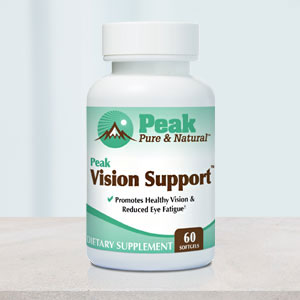Get Easy Health Digest™ in your inbox and don’t miss a thing when you subscribe today. Plus, get the free bonus report, Mother Nature’s Tips, Tricks and Remedies for Cholesterol, Blood Pressure & Blood Sugar as my way of saying welcome to the community!
The free solution to ‘dry eye’ you can do at home

Each time you blink, your eyes are naturally covered with a substance known as “tear film” — and while that sounds similar to “tears,” it isn’t necessarily the same thing.
In fact, while there are three forms of tears, based on what gets them flowing, tear film itself is actually an essential protective coating that keeps your eye function going strong.
When your tear film is healthy, your eyes feel great.
But when that film is compromised, you suffer from dry, irritated eyes.
Eyes that burn, itch, sting and leave you blinking again and again in desperation.
And while drug companies would love you to rely on them to handle the problem, the truth is one of the most popular prescriptions for dry eyes was considered so ineffective it actually failed its FDA review its first time out.
Luckily, according to University of Waterloo researchers, dry eye sufferers might just be able to skip the prescriptions and even the over-the-counter drops and, instead, simply exercise a little to find relief.
The importance of tear film
Before we go further though, let’s dig a little more into what exactly tear film is and how problems with it can lead to dry eyes.
As we said, tear film acts as a coating for the surface of your eyes. Made up of three layers – oil, water and mucin – it works to hydrate your eyes, guarding them against infection-causing irritants like dust and dirt.
However, since tear film isn’t static, it can become unstable. When this happens the surface of your eyes can develop dry spots and experience symptoms like itchiness, stinging and burning that can drive you crazy.
Sadly, it’s an issue that’s only accelerating…
“With so much of our activity tied to screen usage, dry eye symptoms are becoming increasingly common,” said Heinz Otchere, a Ph.D. candidate in vision science at Waterloo. “Instead of having to use eye drops or other alternative treatments, our study aimed to determine if remaining physically active can be an effective preventative measure against dryness.”
Exercise versus dry eyes
The researchers divided 52 participants into two groups — the athletes and those who would rather skip the gym. And they asked both to participate in aerobic exercise but at different levels.
While the non-athletes exercised no more than once a week, the athletes kicked it up a few notches going for at least five times a week.
Before and after each session, the researchers monitored their eyes for tear secretion and break-up time.
And as you might imagine, the athletes grabbed big wins with the largest increase in the health of their tear film.
But don’t count out the non-athletes…
Even the group that only exercised once a week saw a meaningful boost in tear quantity and tear film stability after the exercise session!
“It can be challenging for people to regularly exercise when the demand is there to work increasingly longer hours in front of screens,” Otchere said. “However, our findings show physical activity can be really important for not just our overall well-being, but for our ocular health too.”
A few other ways to improve your tear production include omega-3s (from fatty fish or supplements), vitamin D (74% of women deficient in vitamin D have dry eyes), drinking tea or coffee and cutting back on sugar, artificial sweeteners and complex carbs.
Editor’s note: Have you heard of EDTA chelation therapy? It was developed originally to remove lead and other contaminants, including heavy metals, from the body. Its uses now run the gamut from varicose veins to circulation. Click here to discover Chelation: Natural Miracle for Protecting Your Heart and Enhancing Your Health!
Sources:
Exercise can provide relief for dry, itchy eyes — Waterloo News
Why Do We Cry? The Truth Behind Your Tears — Cleveland Clinic













